Lace
 From Britannica 11th Edition (1911)
From Britannica 11th Edition (1911) Lace (corresponding to Ital. merletto, trina; Genoese pizzo; Ger. spitzen; Fr. dentelle; Dutch kanten; Span. encaje; the English word owes something to the Fr. lassis or lacis, but both are connected with the earlier Lat. laqueus; early French laces were also called passements or insertions and dents or edgings), the name applied to ornamental open work formed of threads of flax, cotton, silk, gold or silver, and occasionally of mohair or aloe fibre, looped or plaited or twisted together by hand, (1) with a needle, when the work is distinctively known as “needlepoint lace”; (2) with bobbins, pins and a pillow or cushion, when the work is known as “pillow lace”; and (3) by steam-driven machinery, when imitations of both needlepoint and pillow laces are produced. Lace-making implies the production of ornament and fabric concurrently. Without a pattern or design the fabric of lace cannot be made.
The publication of patterns for needlepoint and pillow laces dates from about the middle of the 16th century. Before that period lace described such articles as cords and narrow braids of plaited and twisted threads, used not only to fasten shoes, sleeves and corsets together, but also in a decorative manner to braid the hair, to wind round hats, and to be sewn as trimmings upon costumes. In a Harleian MS. of the time of Henry VI. and Edward IV., about 1471, directions are given for the making of “lace Bascon, lace indented, lace bordered, lace covert, a brode lace, a round lace, a thynne lace, an open lace, lace for hattys,” &c. The MS. opens with an illuminated capital letter, in which is the figure of a woman making these articles. The MS. supplies a clear description how threads in combinations of twos, threes, fours, fives, to tens and fifteens, were to be twisted and plaited together. Instead of the pillow, bobbins and pins with which pillow lace soon afterwards was made, the hands were used, each finger of a hand serving as a peg upon which was placed a “bowys” or “bow,” or little ball of thread. Each ball might be of different colour from the other. The writer of the MS. says that the first finger next the thumb shall be called A, the next B, and so on. According to the sort of cord or braid to be made, so each of the four fingers, A, B, C, D might be called into service. A “thynne lace” might be made with three threads, and then only fingers A, B, C would be required. A “round” lace, stouter than the “thynne” lace, might require the service of four or more fingers. By occasionally dropping the use of threads from certain fingers a sort of indented lace or braid might be made. But when laces of more importance were wanted, such as a broad lace for “hattys,” the fingers on the hands of assistants were required. The smaller cords or “thynne laces,” when fastened in simple or fantastic loops along the edges of collars and cuffs, were called “purls” (see the small edge to the collar worn by Catherine de’ Medici, Pl. II. fig. 4). In another direction from which some suggestion may be derived as to the evolution of lace-making, notice should be taken of the fact that at an early period the darning of varied ornamental devices, stiff and geometric in treatment into hand-made network of small square meshes (see squares of “lacis,” Pl. I. fig. 1) became specialized in many European countries. This is held by some writers to be “opus filatorium,” or “opus araneum” (spider work). Examples of this “opus filatorium,” said to date from the 13th century exist in public collections. The productions of this darning in the early part of the 16th century came to be known as “punto a maglia quadra” in Italy and as “lacis” in France, and through a growing demand for household and wearing linen, very much of the “lacis” was made in white threads not only in Italy and France but also in Spain. In appearance it is a filmy fabric. With white threads also were the “purlings” above mentioned made, by means of leaden bobbins or “fuxii,” and were called “merletti a piombini” (see lower border, Pl. II. fig. 3). Cut and drawn thread linen work (the latter known as “tela tirata” in Italy and as “deshilado” in Spain) were other forms of embroidery as much in vogue as the darning on net and the “purling.” The ornament of much of this cut and drawn linen work (see collar of Catherine de’ Medici, Pl. II. fig. 4), more restricted in scope than that of the darning on net, was governed by the recurrence of open squares formed by the withdrawal of the threads. Within these squares and rectangles radiating devices usually were worked by means of whipped and buttonhole stitches (Pl. fig. 5). The general effect in the linen was a succession of insertions or borders of plain or enriched reticulations, whence the name “punto a reticella” given to this class of embroidery in Italy. Work of similar style and especially that with whipped stitches was done rather earlier in the Grecian islands, which derived it from Asia Minor and Persia. The close connexion of the Venetian republic with Greece and the eastern islands, as well as its commercial relations with the East, sufficiently explains an early transplanting of this kind of embroidery into Venice, as well as in southern Spain. At Venice besides being called “reticella,” cut work was also called “punto tagliato.” Once fairly established as home industries such arts were quickly exploited with a beauty and variety of pattern, complexity of stitch and delicacy of execution, until insertions and edgings made independently of any linen as a starting base (see first two borders, Pl. II. fig. 3) came into being under the name of “Punto in aria” (Pl. II. fig. 7). This was the first variety of Venetian and Italian needlepoint lace in the middle of the 16th century,1 and its appearance then almost coincides in date with that of the “merletti a piombini,” which was the earliest Italian cushion or pillow lace (see lower edging, Pl. II. fig. 3).
The many varieties of needlepoint and pillow laces will be touched on under the heading allotted to each of these methods of making lace. Here, however, the general circumstances of their genesis may be briefly alluded to. The activity in cord and braid-making and in the particular sorts of ornamental needlework already mentioned clearly postulated such special labour as was capable of being converted into lace-making. And from the 16th century onwards the stimulus to the industry in Europe was afforded by regular trade demand, coupled with the exertions of those who encouraged their dependents or protegés to give their spare time to remunerative home occupations. Thus the origin and perpetuation of the industry have come to be associated with the women folk of peasants and fishermen in circumstances which present little dissimilarity whether in regard to needle lace workers now making lace in whitewashed cottages and cabins at Youghal and Kenmare in the south of Ireland, or those who produced their “punti in aria” during the 16th century about the lagoons of Venice, or Frenchwomen who made the sumptuous “Points de France” at Alençon and elsewhere in the 17th and 18th centuries; or pillow lace workers to be seen at the present day at little seaside villages tucked away in Devonshire dells, or those who were engaged more than four hundred years ago in “merletti a piombini” in Italian villages or on “Dentelles au fuseau” in Flemish lowlands. The ornamental character, however, of these several laces would be found to differ much; but methods, materials, appliances and opportunities of work would in the main be alike. As fashion in wearing laces extended, so workers came to be drawn together into groups by employers who acted as channels for general trade.2 Nuns in the past as in the present have also devoted attention to the industry, often providing in the convent precincts workrooms not only for peasant women to carry out commissions in the service of the church or for the trade, but also for the purpose of training children in the art. Elsewhere lace schools have been founded by benefactors or organized by some leading local lace-maker3 as much for trading as for education. In all this variety of circumstance, development of finer work has depended upon the abilities of the workers being exercised under sound direction, whether derived through their own intuitions, or supplied by intelligent and tasteful employers. Where any such direction has been absent the industry viewed commercially has suffered, its productions being devoid of artistic effect or adaptability to the changing tastes of demand.
It is noteworthy that the two widely distant regions of Europe where pictorial art first flourished and attained high perfection, north Italy and Flanders, were precisely the localities where lace-making first became an industry of importance both from an artistic and from a commercial point of view. Notwithstanding more convincing evidence as to the earlier development of pillow lace making in Italy the invention of pillow lace is often credited to the Flemings; but there is no distinct trace of the time or the locality. In a picture said to exist in the church of St Gomar at Lierre, and sometimes attributed to Quentin Matsys (1495), is introduced a girl apparently working at some sort of lace with pillow, bobbins, &c., which are somewhat similar to the implements in use in more recent times.4 From the very infancy of Flemish art an active intercourse was maintained between the Low Countries and the great centres of Italian art; and it is therefore only what might be expected that the wonderful examples of the art and handiwork of Venice in lace-making should soon have come to be known to and rivalled among the equally industrious, thriving and artistic Flemings. At the end of the 16th century pattern-books were issued in Flanders having the same general character as those published for the guidance of the Venetian and other Italian lace-makers.
Plate I.
 |
Fig. 1.—PORTION OF A COVERLET COMPOSED OF SQUARES OF “LACIS” OR DARNED NETTING, DIVIDED BY LINEN CUT-WORK BANDS. |
 |
Fig. 2.—CORNER OF A BED-COVER OF PILLOW-MADE LACE OF A TAPE-LIKE TEXTURE WITH CHARACTERISTICS IN THE TWISTED AND
PLAITED THREADS RELATING THE WORK TO ITALIAN “MERLETTI A
PIOMBINI” OR EARLY ENGLISH “BONE LACE.” |
Plate II.
|
|
 |
| Fig. 24.—Portion of a Flounce of Needlepoint Lace, French, early 18th century, “Point de France.” The honeycomb ground is considered to be a peculiarity of “Point d’Argentan”: some of the fillings are made in the manner of the “Point d’Alençon” réseau. |
France and England were not far behind Venice and Flanders in making needle and pillow lace. Henry III. of France (1574-1589) appointed a Venetian, Frederic Vinciolo, pattern maker for varieties of linen needle works and laces to his court. Through the influence of this fertile designer the seeds of a taste for lace in France were principally sown. But the event which par excellence would seem to have fostered the higher development of the French art of lace-making was the aid officially given it in the following century by Louis XIV., acting on the advice of his minister Colbert. Intrigue and diplomacy were put into action to secure the services of Venetian lace-workers; and by an edict dated 1665 the lace-making centres at Alençon, Quesnoy, Arras, Reims, Sedan, Château Thierry, Loudun and elsewhere were selected for the operations of a company in aid of which the state made a contribution of 36,000 francs; at the same time the importation of Venetian, Flemish and other laces was strictly forbidden.5 The edict contained instructions that the lace-makers should produce all sorts of thread work, such as those done on a pillow or cushion and with the needle, in the style of the laces made at Venice, Genoa, Ragusa and other places; these French imitations were to be called “points de France.” By 1671 the Italian ambassador at Paris writes, “Gallantly is the minister Colbert on his way to bring the ‘lavori d’aria’ to perfection.” Six years later an Italian, Domenigo Contarini, alludes to the “punto in aria,” “which the French can now do to admiration.” The styles of design which emanated from the chief of the French lace centre, Alençon, were more fanciful and less severe than the Venetian, and it is evident that the Flemish lace-makers later on adopted many of these French patterns for their own use. The provision of French designs (fig. 24) which owes so much to the state patronage, contrasts with the absence of corresponding provision in England and was noticed early in the 18th century by Bishop Berkeley. “How,” he asks, “could France and Flanders have drawn so much money from other countries for figured silk, lace and tapestry, if they had not had their academies of design?”
The humble endeavours of peasantry in England (which could boast of no schools of design), Germany, Sweden, Russia and Spain could not result in work of so high artistic pretension as that of France and Flanders. In the 18th century good lace was made in Devonshire, but it is only in recent years that to some extent the hand lace-makers of England and Ireland have become impressed with the necessity of well-considered designs for their work. Pillow lace making under the name of “bone lace making” was pursued in the 17th century in Buckinghamshire, Hertfordshire and Bedfordshire, and in 1724 Defoe refers to the manufacture of bone lace in which villagers were “wonderfully exercised and improved within these few years past.” “Bone” lace dates from the 17th century in England and was practically the counterpart of Flemish “dentelles au fuseau,” and related also to the Italian “merletti a piombini” (see Pl. fig. 10). In Germany, Barbara Uttmann, a native of Nuremberg, instructed peasants of the Harz mountains to twist and plait threads in 1561. She was assisted by certain refugees from Flanders. A sort of “purling” or imitation of the Italian “merletti a piombini” was the style of work produced then.
Lace of comparatively simple design has been made for centuries in villages of Andalusia as well as in Spanish conventual establishments. The “point d’Espagne,” however, appears to have been a commercial name given by French manufacturers of a class of lace made in France with gold or silver threads on the pillow and greatly esteemed by Spaniards in the 17th century. No lace pattern-books have been found to have been published in Spain. The needle-made laces which came out of Spanish monasteries in 1830, when these institutions were dissolved, were mostly Venetian needle-made laces. The lace vestments preserved at the cathedral at Granada hitherto presumed to be of Spanish work are verified as being Flemish of the 17th century (similar in style to Pl. fig. 14). The industry is not alluded to in Spanish ordinances of the 15th, 16th or 17th centuries, but traditions which throw its origin back to the Moors or Saracens are still current in Seville and its neighbourhood, where a twisted and knotted arrangement of fine cords is often worked6 under the name of “Morisco” fringe, elsewhere called macramé lace. Black and white silk pillow laces, or “blondes,” date from the 18th century. They were made in considerable quantity in the neighbourhood of Chantilly, and imported for mantillas by Spain, where corresponding silk lace making was started. Although after the 18th century the making of silk laces more or less ceased at Chantilly and the neighbourhood, the craft is now carried on in Normandy—at Bayeux and Caen—as well as in Auvergne, which is also noted for its simple “torchon” laces. Silk pillow lace making is carried on in Spain, especially at Barcelona. The patterns are almost entirely imitations from 18th-century French ones of a large and free floral character. Lace-making is said to have been promoted in Russia through the patronage of the court, after the visit of Peter the Great to Paris in the early days of the 18th century. Peasants in the districts of Vologda, Balakhua (Nijni-Novgorod), Bieleff (Tula) and Mzensk (Orel) make pillow laces of simple patterns. Malta is noted for producing a silk pillow lace of black or white, or red threads, chiefly of patterns in which repetitions of circles, wheels and radiations of shapes resembling grains of wheat are the main features. This characteristic of design, appearing in white linen thread laces of similar make which have been identified as Genoese pillow laces of the early 17th century, reappears in Spanish and Paraguayan work. Pillow lace in imitation of Maltese, Buckinghamshire and Devonshire laces is made to a small extent in Ceylon, in different parts of India and in Japan. A successful effort has also been made to re-establish the industry in the island of Burano near Venice, and pillow and needlepoint lace of good design is made there.
At present the chief sources of hand-made lace are France, Belgium, Ireland and England.
France is faithful to her traditions in maintaining a lively and graceful taste in lace-making. Fashion of late years has called for ampler and more boldly effective laces, readily produced with both braids and cords and far less intricate needle or pillow work than was required for the dainty and smaller laces of earlier date.
 |
| Fig. 25.—Collar and Berthe of Irish Crochet Lace. |
 |
| Fig. 26.—Collar of Irish Crochet Lace. |
In Belgium the social and economic conditions are, as they have been in the past, more conducive and more favourable than elsewhere to lace-making at a sufficiently remunerative rate of wages. The production of hand-made laces in Belgium was in 1900 greater than that of France. The principal modern needle-made lace of Belgium is the “Point de Gaze”; “Duchesse” and Bruges laces are the chief pillow-made laces; whilst “Point Appliqué” and “Plat Appliqué” are frequently the results not only of combining needle-made and pillow work, but also of using them in conjunction with machine-made net. Ireland is the best producer of that substantial looped-thread work known as crochet (see figs. 25, 26, 27), which must be regarded as a hand-made lace fabric although not classifiable as a needlepoint or pillow lace. It is also quite distinct in character from pseudo-laces, which are really embroideries with a lace-like appearance, e.g. embroideries on net, cut and embroidered cambrics and fine linen. For such as these Ireland maintains a reputation in its admirable Limerick and Carrickmacross laces, made not only in Limerick and Carrickmacross, but also in Kinsale, Newry, Crossmaglen and elsewhere. The demand from France for Irish crochet is now far beyond the supply, a condition which leads not only to the rapid repetition by Irish workers of old patterns, but tends also to a gradual debasement of both texture and ornament. Attempts have been made to counteract this tendency, with some success, as the specimens of Irish crochet in figs. 25, 26 and 27 indicate.
Plate III.
|
|
Plate IV.
|
|
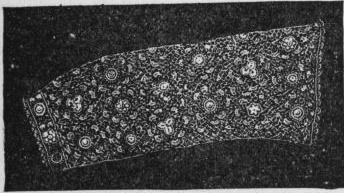 |
| Fig. 27.—Lady’s Sleeve of Irish Crochet Lace. |
An appreciable amount of pillow-made lace is annually supplied from Devonshire, Buckinghamshire, Bedfordshire and Northampton, but it is bought almost wholly for home use. The English laces are made almost entirely in accordance with the precedents of the 19th century—that is to say, in definite lengths and widths, as for borders, insertions and flounces, although large shaped articles, such as panels for dresses, long sleeves complete skirts, jackets, blouses, and fancifully shaped collars of considerable dimensions have of late been freely made elsewhere. To make such things entirely of lace necessitates many modifications in the ordinary methods; the English lace-workers are slow to adapt their work in the manner requisite, and hence are far behind in the race to respond to the fashionable demand. No countries succeed so well in promptly answering the variable call of fashion as France and Belgium.
As regards trade in lace, America probably buys more from Belgium than from France; France and England come next as purchasers of nearly equal quantities, after which come Russia and Italy.
The greatest amount of lace now made is that which issues from machines in England, France and Germany. The total number of persons employed in the lace industry in England in 1871 was 49,370, and in 1901 about 34,929, of whom not more than 5000 made lace by hand.
The early history7 of the lace-making machine coincides with that of the stocking frame, that machine having been adapted about the year 1768 for producing open-looped fabrics which had a net-like appearance. About 1786 frames for making point nets by machinery first appear at Mansfield and later at Ashbourne and Nottingham and soon afterwards modifications were introduced into such frames in order to make varieties of meshes in the point nets which were classed as figured nets. In 1808 and 1809 John Heathcoat of Nottingham obtained patents for machines for making bobbin net with a simpler and more readily produced mesh than that of the point net just mentioned. For at least thirty years thousands of women had been employed in and about Nottingham in the embroidery of simple ornament on net. In 1813 John Leavers began to improve the figured net weaving machines above mentioned, and from these the lace-making machines in use at the present time were developed. But it was the application of the celebrated Jacquard apparatus to such machines that enabled manufacturers to produce all sorts of patterns in thread-work in imitation of the patterns for hand-made lace. A French machine called the “dentellière” was devised (see La Nature for the 3rd of March 1881), and the patterns produced by it were of plaited threads. The expense, however, attending the production of plaited lace by the “dentellière” is as great as that of pillow lace made by the hand, and so the machine has not succeeded for ordinary trade purposes. More successful results have been secured by the new patent circular lace machine of Messrs. Birkin & Co. of Nottingham, the productions of which, all of simple design, cannot be distinguished from hand-made pillow lace of the same style (see figs. 57, 58, 59).
Before dealing with technical details in processes of making lace whether by hand or by the machine, the component parts of different makes of lace may be considered. These are governed by the ornaments or patterns, which may be so designed, as they were in the earlier laces, that the different component parts may touch one another without any intervening groundwork. But as a wish arose to vary the effect of the details in a pattern ground-works were gradually developed and at first consisted of links or ties between the substantial parts of the pattern. The bars or ties were succeeded by grounds of meshes, like nets. Sometimes the substantial parts of a pattern were outlined with a single thread or by a strongly marked raised edge of buttonhole-stitched or of plaited work. Minute fanciful devices were then introduced to enrich various portions of the pattern. Some of the heavier needle-made laces resemble low relief carving in ivory, and the edges of the relief portions are often decorated with clusters of small loops. For the most part all this elaboration was brought to a high pitch of variety and finish by French designers and workers; and French terms are more usual in speaking of details in laces. Thus the solid part of the pattern is called the toilé or clothing, the links or ties are called brides, the meshed grounds are called réseaux, the outline to the edges of a pattern is called cordonnet or brodé, the insertions of fanciful devices modes, the little loops picots. These terms are applicable to the various portions of laces made with the needle, on the pillow or by the machine.
The sequence of patterns in lace (which may be verified upon referring to figs. 1 to 23) is roughly as follows. From about 1540 to 1590 they were composed of geometric forms set within squares, or of crossed and radiating line devices, resulting in a very open fabric, stiff and almost wiry in effect, without brides or réseaux. From 1590 may be dated the introduction into patterns of very conventional floral and even human and animal forms and slender scrolls, rendered in a tape-like texture, held together by brides. To the period from 1620 to 1670 belongs the development of long continuous scroll patterns with réseaux and brides, accompanied in the case of needle-made laces with an elaboration of details, e.g. cordonnet with massings of picots. Much of these laces enriched with fillings or modes was made at this time. From 1650 to 1700 the scroll patterns gave way to arrangements of detached ornamental details (as in Pl. VI. fig. 22): and about 1700 to 1760 more important schemes or designs were made (as in Pl. fig. 19, and in fig. 24 in text), into which were introduced naturalistic renderings of garlands, flowers, birds, trophies, architectural ornament and human figures. Grounds composed entirely of varieties of modes as in the case of the réseau rosacé (Pl. V. fig. 21) were sometimes made then. From 1760 to 1800 small details consisting of bouquets, sprays of flowers, single flowers, leaves, buds, spots and such like were adopted, and sprinkled over meshed grounds, and the character of the texture was gauzy and filmy (as in figs. 40 and 42). Since that time variants of the foregoing styles of pattern and textures have been used according to the bent of fashion in favour of simple or complex ornamentation, or of stiff, compact or filmy textures.
 |
| Fig. 28. Fig. 29. |
Needlepoint Lace.—The way in which the early Venetian “punto in aria” was made corresponds with that in which needlepoint lace is now worked. The pattern is first drawn upon a piece of parchment. The parchment is then stitched to two pieces of linen. Upon the leading lines drawn on the parchment a thread is laid, and fastened through to the parchment and linen by means of stitches, thus constructing a skeleton thread pattern (see left-hand part of fig. 30). Those portions which are to be represented as the “clothing” or toilé are usually worked as indicated in the enlarged diagram (fig. 29), and then edged as a rule with buttonhole stitching (fig. 28). Between these toilé portions of the pattern are worked ties (brides) or meshes (réseaux), and thus the various parts united into one fabric are wrought on to the face of the parchment pattern and reproducing it (see right-hand part of fig. 30). A knife is passed between the two pieces of linen at the back of the parchment, cutting the stitches which have passed through the parchment and linen, and so releasing the lace itself from its pattern parchment. In the earlier stages, the lace was made in lengths to serve as insertions (passements) and also in vandykes (dentelles) to serve as edgings. Later on insertions and vandykes were made in one piece. All of such were at first of a geometric style of pattern (Pl. figs. 3-5 and 6).
 |
| Fig. 30.—Parchment Pattern showing work in progress: the more complete lace is on the right half of the pattern. |
 |
| Fig. 31. |
Following closely upon them came the freer style of design already mentioned, without and then with links or ties—brides—interspersed between the various details of the patterns (Pl. II. fig. 7), which were of flat tape-like texture. In elaborate specimens of this flat point lace some lace workers occasionally used gold thread with the white thread. These flat laces (“Punto in Aria”) are also called “flat Venetian point.” About 1640 “rose (raised) point” laces began to be made (Pl. III. fig. 12). They were done in relief and those of bold design with stronger reliefs are called “gros point de Venise.” Lace of this latter class was used for altar cloths, flounces, jabots or neckcloths which hung beneath the chin over the breast (Pl. III. fig. 11), as well as for trimming the turned-over tops of jack boots. Tabliers and ladies’ aprons were also made of such lace. In these no regular ground was introduced. All sorts of minute embellishments, like little knots, stars and loops or picots, were worked on to the irregularly arranged brides or ties holding the main patterns together, and the more dainty of these raised laces (Pl. fig. 17) exemplify the most subtle uses to which the buttonhole stitch appears capable of being put in making ornaments. But about 1660 came laces with brides or ties arranged in a honeycomb reticulation or regular ground. To them succeeded lace in which the compact relief gave place to daintier and lighter material combined with a ground of meshes or réseau. The needle-made meshes were sometimes of single and sometimes of double threads. A diagram is given of an ordinary method of making such meshes (fig. 31). At the end of the 17th century the lightest of the Venetian needlepoint laces were made; and this class which was of the filmiest texture is usually known as “point de Venise à réseau” (Pl. V. fig. 20a). It was contemporary with the needle-made French laces of Alençon and Argentan8 that became famous towards the latter part of the 17th century (Pl. V. fig. 20b). “Point d’Argentan” has been thought to be especially distinguished on account of its delicate honeycomb ground of hexagonally arranged brides (fig. 32), a peculiarity already referred to in certain antecedent Venetian point laces. Often intermixed with this hexagonal brides ground is the fine-meshed ground or réseau (fig. 20b), which has been held to be distinctive of “point d’Alençon.” But the styles of patterns and the methods of working them, with rich variety of insertions or modes, with the brodé or cordonnet of raised buttonhole stitched edging, are alike in Argentan and Alençon needle-made laces (Pl. V. fig. 20b and fig. 32). Besides the hexagonal brides ground and the ground of meshes another variety of grounding (réseau rosacé) was used in certain Alençon designs. This ground consisted of buttonhole-stitched skeleton hexagons within each of which was worked a small hexagon of toilé connected with the outer surrounding hexagon by means of six little ties or brides (Pl. V. fig. 21). Lace with this particular ground has been called “Argentella,” and some writers have thought that it was a specialty of Genoese or Venetian work. But the character of the work and the style of the floral patterns are those of Alençon laces. The industry at Argentan was virtually an offshoot of that nurtured at Alençon, where “lacis,” “cut work” and “vélin” (work on parchment) had been made for years before the well-developed needle-made “point d’Alençon” came into vogue under the favouring patronage of the state-aided lace company mentioned as having been formed in 1665. Madame Despierre in her Histoire du point d’Alençon gives an interesting and trustworthy account of the industry.
 |
| Fig. 32.—Border of Needlepoint Lace made in France about 1740-1750, the clear hexagonal mesh ground, which is compactly stitched, being usually regarded as characteristic of the point de France made at Argentan. |
In Belgium, Brussels has acquired some celebrity for needle-made laces. These, however, are chiefly in imitation of those made at Alençon, but the toilé is of less compact texture and sharpness in definition of pattern. Brussels needlepoint lace is often worked with meshed grounds made on a pillow, and a plain thread is used as a cordonnet for their patterns instead of a thread overcast with buttonhole stitches as in the French needlepoint laces. Note the bright sharp outline to the various ornamental details in Pl. V. fig. 20b.
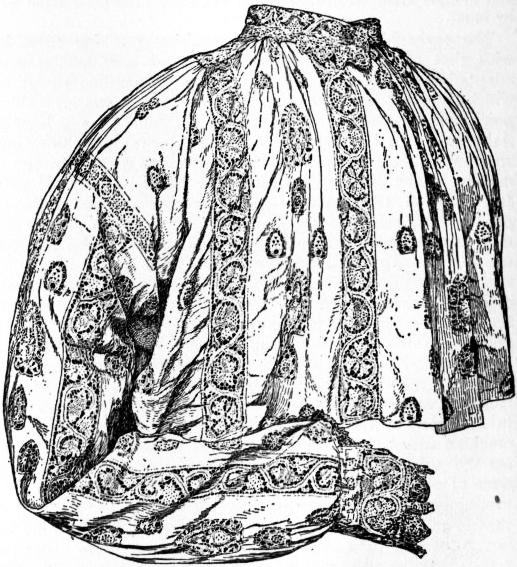 |
| Fig. 33.—Shirt decorated with Insertions of Flat Needlepoint Lace. (English, 17th century. Victoria and Albert Museum.) |
Plate IV.
|
|
Plate VI.
 |
| Fig. 22.—JABOT OR CRAVAT OF PILLOW-MADE LACE. Brussels. Late 17th century. (Victoria and Albert Museum.) |
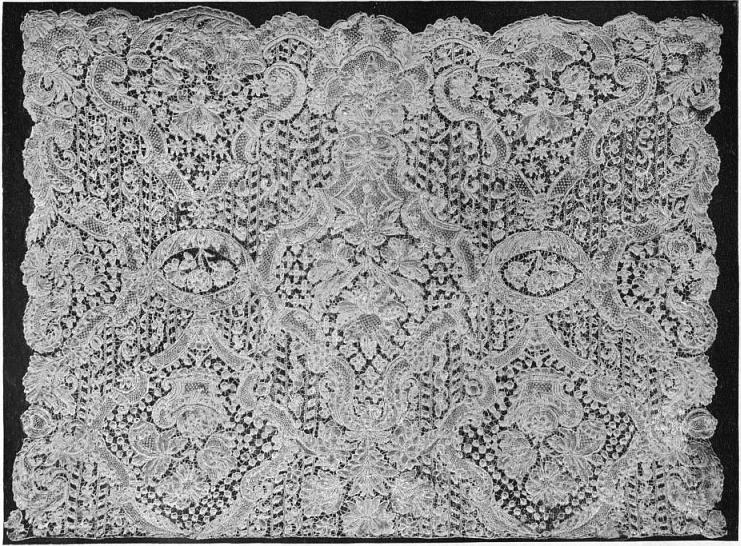 |
| Fig. 23.—JABOT OR CRAVAT OF PILLOW-MADE LACE OF FANTASTIC FLORAL DESIGN, THE GROUND OF WHICH IS COMPOSED OF LITTLE FLOWERS AND LEAVES ARRANGED WITHIN SMALL OPENWORK VERTICAL STRIPS. |
| Brussels. 18th century. (Victoria and Albert Museum.) |
Needlepoint lace has also been occasionally produced in England. Whilst the character of its design in the early 17th century was rather more primitive, as a rule, than that of the contemporary Italian, the method of its workmanship is virtually the same and an interesting specimen of English needle-made lace inset into an early 17th-century shirt is illustrated in fig. 33. Specimens of needle-made work done by English school children may be met with in samplers of the 17th and 18th centuries. Needlepoint lace is successfully made at Youghal, Kenmare and New Ross in Ireland, where of late years attention has been given to the study of designs for it. The lace-making school at Burano near Venice produces hand-made laces which are, to a great extent, careful reproductions of the more celebrated classes of point laces, such as “punto in aria,” “rose point de Venise,” “point de Venise à réseau,” “point d’Alençon,” “point d’Argentan” and others. Some good needlepoint lace is made in Bohemia and elsewhere in the Austrian empire.
Pillow-made Lace.—Pillow-made lace is built upon no substructure corresponding with a skeleton thread pattern such as is used for needlepoint lace, but is the representation of a pattern obtained by twisting and plaiting threads.
These patterns were never so strictly geometric in style as those adopted for the earliest point lace making from the antecedent cut linen and drawn thread embroideries. Curved forms, almost at the outset of pillow lace, seem to have been found easy of execution (see lower border, Pl. II. fig. 3); its texture was more lissom and less crisp and wiry in appearance than that of contemporary needle-made lace. The early twisted and plaited thread laces, which had the appearance of small cords merging into one another, were soon succeeded by laces of similar make but with flattened and broader lines more like fine braids or tapes (Pl. I. fig. 2, and Pl. fig. 10). But pillow laces of this tapey character must not be confused with laces in which actual tape or braid is used. That peculiar class of lace-work does not arise until after the beginning of the 17th century when the weaving of tape is said to have commenced in Flanders. In England this sort of tape-lace dates no farther back than 1747, when two Dutchmen named Lanfort were invited by an English firm to set up tape looms in Manchester.
 |
| Fig. 34.—Diagram showing six Bobbins in use. |
 |
| Fig. 35. |
The process by which lace is made on the pillow is roughly and briefly as follows. A pattern is first drawn upon a piece of paper or parchment. It is then pricked with holes by a skilled “pattern pricker,” who determines where the principal pins shall be stuck for guiding the threads. This pricked pattern is then fastened to the pillow. The pillow or cushion varies in shape in different countries. Some lace-makers use a circular pad, backed with a flat board, in order that it may be placed upon a table and easily moved. Other lace-workers use a well-stuffed round pillow or short bolster, flattened at the two ends, so that they may hold it conveniently on their laps. From the upper part of pillow with the pattern fastened on it hang the threads from the bobbins. The bobbin threads thus hang across the pattern. Fig. 34 shows the commencement, for instance, of a double set of three-thread plaitings. The compact portion in a pillow lace has a woven appearance (fig. 35).
About the middle of the 17th century pillow lace of formal scroll patterns somewhat in imitation of those for point lace was made, chiefly in Flanders. The earlier of these had grounds of ties or brides and was often called “point de Flandres” (Pl. fig. 14) in contradistinction to scroll patterns with a mesh ground, which were called “point d’Angleterre” (Pl. fig. 16). Into Spain and France much lace from Venice and Flanders was imported as well as into England, where from the 16th century the manufacture of the simple pattern “bone lace” by peasants in the midland and southern counties was still being carried on. In Charles II.’s time its manufacture was threatened with extinction by the preference given to the more artistic and finer Flemish laces. The importation of the latter was accordingly prohibited. Dealers in Flemish lace sought to evade the prohibitions by calling certain of their laces “point d’Angleterre,” and smuggling them into England. But smuggling was made so difficult that English dealers were glad to obtain the services of Flemish lace-makers and to induce them to settle in England. It is from some such cause that the better 17th- and 18th-century English pillow laces bear resemblance to pillow laces of Brussels, of Mechlin and of Valenciennes.
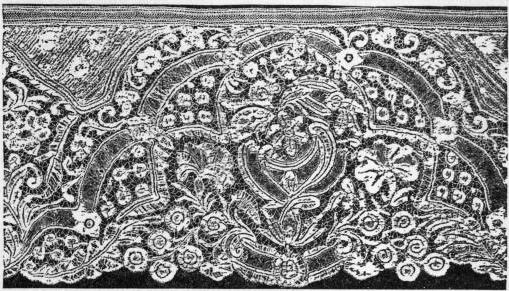 |
| Fig. 36.—Border of English Pillow-made (Devonshire) Lace in the style of a Brussels design of the middle of the 18th century. |
 |
| Fig. 37—Border of English (Bucks. or Beds.) Pillow-made Lace in the Style of a Mechlin design of the latter part of the 18th century. |
 |
| Fig. 38—Border of Pillow-made Lace, Mechlin, from a design similar to such as was used for point d’Alençon of the Louis XV. period. |
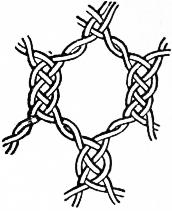 |
| Fig. 39.—Mechlin Mesh. |
As skill in the European lace-making developed soon after the middle of the 17th century, patterns and particular plaitings came to be identified with certain localities. Mechlin, for instance, enjoyed a high reputation for her productions. The chief technical features of this pillow lace lie in the plaiting of the meshes, and the outlining of the clothing or toilé with a thread cordonnet. The ordinary Mechlin mesh is hexagonal in shape. Four of the sides are of double twisted threads, two are of four threads plaited three times (fig. 39).
In Brussels pillow lace, which has greater variety of design, the mesh is also hexagonal; but in contrast with the Mechlin mesh whilst four of its sides are of double-twisted threads the other two are of four threads plaited four times (fig. 41). The finer specimens of Brussels lace are remarkable for the fidelity and grace with which the botanical forms in many of its patterns are rendered (Pl. VI. fig. 23). These are mainly reproductions or adaptations of designs for point d’Alençon, and the soft quality imparted to them in the texture of pillow-made lace contrasts with the harder and more crisp appearance in needlepoint lace. An example of dainty Brussels pillow lace is given in fig. 42. In the Brussels pillow lace a delicate modelling effect is often imparted to the close textures of the flowers by means of pressing them with a bone instrument which gives concave shapes to petals and leaves, the edges of which consist in part of slightly raised cordonnet of compact plaited work.
 |
| Fig. 40.—Border of Pillow-made Lace, Mechlin, end of the 18th century. |
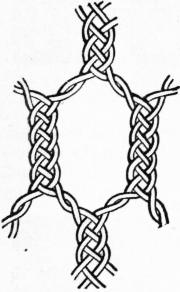 |
| Fig. 41.—Enlargement of Brussels Mesh. |
 |
| Fig. 42.—Portion of a Wedding Veil, 7 ft. 6 in. × 6 ft. 6 in., of Pillow-made Lace, Brussels, late 18th century. The design consists of light leafy garlands of orange blossoms and other flowers daintily festooned. Little feathery spirals and stars are powdered over the ground, which is of Brussels vrai réseau. In the centre upon a more open ground of pillow-made hexagonal brides is a group of two birds, one flying towards the other which appears ready to take wing from its nest; an oval frame containing two hearts pierced by an arrow, and a hymeneal torch. Throughout this veil is a profusion of pillow renderings of various modes, the réseau rosacé, star devices, &c. The ornamental devices are partly applied and partly worked into the ground (Victoria and Albert Museum). |
Honiton pillow lace resembles Brussels lace, but in most of the English pillow laces (Devonshire, Buckinghamshire, Bedfordshire) the réseau is of a simple character (fig. 43). As a rule, English lace is made with a rather coarser thread than that used in the older Flemish laces. In real Flemish Valenciennes lace there are no twisted sides to the mesh; all are closely plaited (fig. 44) and as a rule the shape of the mesh is diamond but without the openings as shown in fig. 44. No outline or cordonnet to define the pattern is used in Valenciennes lace (see fig. 45). Much lace of the Valenciennes type (fig. 54) is made at Ypres. Besides these distinctive classes of pillow-like laces, there are others in which equal care in plaiting and twisting threads is displayed, though the character of the design is comparatively simple, as for instance in ordinary pillow laces from Italy, from the Auvergne, from Buckinghamshire, or rude and primitive as in laces from Crete, southern Spain and Russia. Pillow lace-making in Crete is now said to be extinct. The laces were made chiefly of silk. The patterns in many specimens are outlined with one, two or three bright-coloured silken threads. Uniformity in simple character of design may also be observed in many Italian, Spanish, Bohemian, Swedish and Russian pillow laces (see the lower edge of fig. 46).
 |
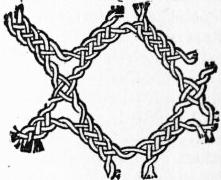 |
| Fig. 43. | Fig. 44. |
 |
| Fig. 45.—Lappet of delicate Pillow-made Lace, Valenciennes, about 1750. The peculiarity of Valenciennes lace is the filmy cambric-like texture and the absence of any cordonnet to define the separate parts of the ornament such as is used in needlepoint lace of Alençon, and in pillow Mechlin and Brussels lace. |
Guipure.—This name is often applied to needlepoint and pillow laces in which the ground consists of ties or brides, but it more properly designates a kind of lace or “passementerie,” made with gimp of fine wires whipped round with silk, and with cotton thread. An earlier kind of gimp was formed with “Cartisane,” a little strip of thin parchment or vellum covered with silk, gold or silver thread. These stiff gimp threads, formed into a pattern, were held together by stitches worked with the needle. Gold and silver thread laces have been usually made on the pillow, though gold thread has been used with fine effect in 17th-century Italian needlepoint laces.
 |
| Fig. 46.—Border to a Cloth. The wide part bearing the double-headed eagle of Russia is of drawn thread embroidery: the scalloped edging is of Russian pillow-made lace, though the style of its pattern is often seen in pillow laces made by peasants in Danubian provinces as well as in the south of Spain. |
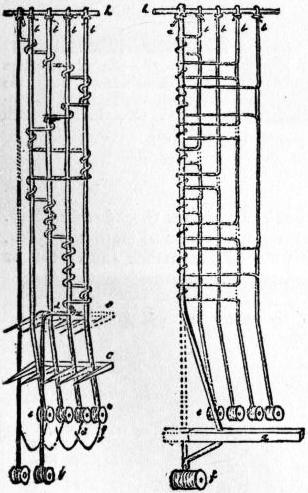 |
| Fig. 47. Fig. 48. |
 |
| Fig. 49.—Section of Lace Machine. |
 |
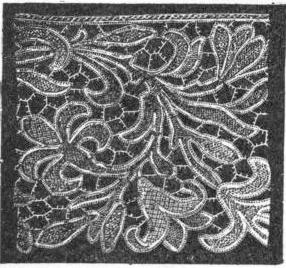 |
| Fig. 50.—Machine-made Lace in imitation of 16th-century Needlepoint “Reticella” Lace. | Fig. 51.—Border of Machine-made Lace in the style of 17th-century Pillow Guipure Lace. |
 |
 |
| Fig. 52.—Border of Machine-made Lace in imitation of 17th-century Pillow Lace. | Fig. 53.—Machine-made Trimming Border in imitation of Irish Crochet Lace. |
 |
| Fig. 54.—A Piece of Hand-made Pillow Lace, Belgian (Ypres), 20th century. (The machine imitation is given in fig. 55.) |
 |
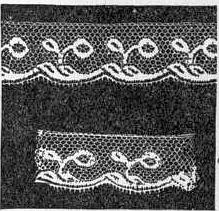 |
| Fig. 55.—Machine-made Lace in imitation of the Hand-made Specimen of fig. 54. (Nottingham, 20th century.) | Fig. 56.—Small Borders (a) Hand-made and (b) Machine-made Lace Valenciennes. (Nottingham, 20th century.) |
 |
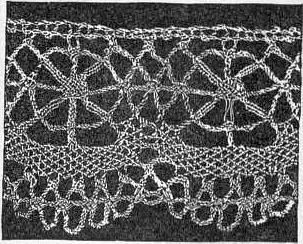 |
| Fig. 57.—Specimen of Hand-made Pillow Lace. | Fig. 58.—Specimen of Machine-made Lace in which the twisting and plaiting of the threads are identical with those of the hand-made specimen of fig. 57. (Nottingham, 20th century.) |
Machine-made Lace.—We have already seen that a technical peculiarity in making needlepoint lace is that a single thread and needle are alone used to form the pattern, and that the buttonhole stitch and other loopings which can be worked by means of a needle and thread mark a distinction between lace made in this manner and lace made on the pillow. For the process of pillow lace making a series of threads are in constant employment, plaited and twisted the one with another. A buttonhole stitch is not producible by it. The Leavers lace machine does not make either a buttonhole stitch or a plait. An essential principle of this machine-made work is that the threads are twisted together as in stocking net. The Leavers lace machine is that generally in use at Nottingham and Calais. French ingenuity has developed improvements in this machine whereby laces of delicate thread are made; but as fast as France makes an improvement England follows with another, and both countries virtually maintain an equal position in this branch of industry. The number of threads brought into operation in a Leavers machine is regulated by the pattern to be produced, the threads being of two sorts, beam or warp threads and bobbin or weft threads. Upwards of 8880 are sometimes used, sixty pieces of lace being made simultaneously, each piece requiring 148 threads—100 beam threads and 48 bobbin threads. The ends of both sets of threads are fixed to a cylinder upon which as the manufacture proceeds the lace becomes wound. The supply of the beam or warp threads is held upon reels, and that of the bobbins or weft threads is held in bobbins. The beam or warp thread reels are arranged in frames or trays beneath the stage, above which and between it and the cylinder the twisting of the bobbin or weft with beam or warp threads takes place. The bobbins containing the bobbin or weft threads are flattened in shape so as to pass conveniently between the stretched beam or warp threads. Each bobbin can contain about 120 yds. of thread. By most ingenious mechanism varying degrees of tension can be imparted to warp and weft threads as required. As the bobbins or weft threads pass like pendulums between the warp threads the latter are made to oscillate, thus causing them to become twisted with the bobbin threads. As the twistings take place, combs passing through both warp and weft threads compress the twistings. Thus the texture of the clothing or toilé in machine-made lace may generally be detected by its ribbed appearance, due to the compressed twisted threads. Figs. 47 and 48 are intended to show effects obtained by varying the tensions of weft and warp threads. For instance, if the weft, as threads b, b, b, b in fig. 47, be tight and the warp thread slack, the warp thread a will be twisted upon the weft threads. But if the warp thread a be tight and the weft threads b, b, b, b, be slack, as in fig. 48, then the weft threads will be twisted on the warp thread. At the same time the twisting in both these cases arises from the conjunction of movements given to the two sets of threads, namely, an oscillation or movement from side to side of the beam or warp threads, and the swinging or pendulum-like movement of the bobbin or weft threads between the warp threads. Fig. 49 is a diagram of a sectional elevation of a lace machine representing its more essential parts. E is the cylinder or beam upon which the lace is rolled as made, and upon which the ends of both warp and weft threads are fastened at starting. Beneath are w, w, w, a series of trays or beams, one above the other, containing the reels of the supplies of warp threads; c, c represent the slide bars for the passage of the bobbin b with its thread from k to k, the landing bars, one on each side of the rank of warp threads; s, t are the combs which take it in turns to press together the twistings as they are made. The combs come away clear from the threads as soon as they have pressed them together and fall into positions ready to perform their pressing operations again. The contrivances for giving each thread a particular tension and movement at a certain time are connected with an adaptation of the Jacquard system of pierced cards. The machine lace pattern drafter has to calculate how many holes shall be punched in a card, and to determine the position of such holes. Each hole regulates the mechanism for giving movement to a thread. Fig. 54 displays a piece of hand-made Valenciennes (Ypres) lace and fig. 55 a corresponding piece woven by the machine. The latter shows the advantage that can be gained by using very fine gauge machines, thus enabling a very close imitation of the real lace to be made by securing a very open and clear réseau or net, such as would be made on a coarse machine, and at the same time to keep the pattern fine and solid and standing out well from the net, as is the case with the real lace, which cannot be done by using a coarse gauge machine. In this example the machine used is a 16 point (that is 32 carriages to the inch), and the ground is made half gauge, that is 8 point, and the weaving is made the full gauge of the machine, that is 16 point. Fig. 56 gives other examples of hand- and machine-made Valenciennes lace. The machine-made lace (b) imitating the real (a) is made on a 14-point machine (that is 28 carriages to the inch), the ground being 7 point and the pattern being full gauge or 14 point. Although the principle in these examples of machine work is exactly the same, in so far that they use half gauge net and full gauge clothing to produce the contrast as mentioned above, the fabrication of these two examples is quite different, that in fig. 55 being an example of tight bobbins or weft, and slack warp threads as shown in fig. 47. Whereas the example in fig. 56 is made with slack bobbins or weft threads and tight warp threads as in fig. 48. In fig. 57 is a piece of hand-made lace of stout thread, very similar to much Cluny lace made in the Auvergne and to the Buckinghamshire “Maltese” lace. Close to it are specimens of lace (figs. 58 and 59) made by the new patent circular lace machine of Messrs Birkin of Nottingham. This machine although very slow in production actually reproduces the real lace, at a cost slightly below that of the hand-made lace. In another branch of lace-making by machinery, mechanical ingenuity, combined with chemical treatment, has led to surprising results (figs. 53 and 50). Swiss, German and other manufacturers use machines in which a principle of the sewing-machine is involved. A fine silken tissue is thereby enriched with an elaborately raised cotton or thread embroidery. The whole fabric is then treated with chemical mordants which, whilst dissolving the silky web, do not attack the cotton or thread embroidery. A relief embroidery possessing the appearance of hand-made raised needlepoint lace is thus produced. Figs. 60 and 61 give some idea of the high quality to which this admirable counterfeit has been brought.
 |
| Fig. 59.—Specimens of Machine-made Torchon Lace, in the same manner as such lace is made on the pillow by hand. (Nottingham, 20th century.) |
 |
| Fig. 60.—Machine-made Lace of Modern Design. |
 |
| Fig. 61.—Machine-made Lace in imitation of 17th-century Needlepoint Lace, “Gros point de Venise.” |
Collections of hand-made lace chiefly exist in museums and technical institutions, as for instance the Victoria and Albert Museum in London, the Musée des Arts Décoratifs in Paris, and museums at Lyons, Nuremberg, Berlin, Turin and elsewhere. In such places the opportunity is presented of tracing in chronological sequence the stages of pattern and texture development.
Literature.—The literature of the art of lace-making is considerable. The series of 16th- and 17th-century lace pattern-books, of which the more important are perhaps those by F. Vinciolo (Paris, 1587), Cesare Vecellio (Venice, 1592), and Isabetta Catanea Parasole (Venice, 1600), not to mention several kindred works of earlier and later date published in Germany and the Netherlands, supplies a large field for exploration. Signor Ongania of Venice published a limited number of facsimiles of the majority of such works. M. Alvin of Brussels issued a brochure in 1863 upon these patterns, and in the same year the marquis Girolamo d’Adda contributed two bibliographical essays upon the same subject to the Gazette des Beaux-Arts (vol. xv. p. 342 seq., and vol. xvii. p. 421 seq.). In 1864 Cavaliere A. Merli wrote a pamphlet (with illustrations) entitled Origine ed uso delle trine a filo di rete; Mons F. de Fertiault compiled a brief and rather fanciful Histoire de la dentelle in 1843, in which he reproduced statements to be found in Diderot’s Encyclopédie, subsequently quoted by Roland de la Platière. The first Report of the Department of Practical Art (1853) contains a “Report on Cotton Print Works and Lace-Making” by Octavius Hudson, and in the first Report of the Department of Science and Art are some “Observations on Lace.” Reports upon the International Exhibitions of 1851 (London) and 1867 (Paris), by M. Aubry, Mrs Palliser and others contain information concerning lace-making. The most important work first issued upon the history of lace-making is that by Mrs Bury Palliser (History of Lace, 1869). In this work the history is treated rather from an antiquarian than a technical point of view; and wardrobe accounts, inventories, state papers, fashionable journals, diaries, plays, poems, have been laid under contribution with surprising diligence. A new edition published in 1902 presents the work as entirely revised, rewritten and enlarged under the editorship of M. Jourdain and Alice Dryden. In 1875 the Arundel Society brought out Ancient Needlepoint and Pillow Lace, a folio volume of permanently printed photographs taken from some of the finest specimens of ancient lace collected for the International Exhibition of 1874. These were accompanied by a brief history of lace, written from the technical aspect of the art, by Alan S. Cole. At the same time appeared a bulky imperial 4to volume by Seguin, entitled La Dentelle, illustrated with wood-cuts and fifty photo-typographical plates. Seguin divides his work into four sections. The first is devoted to a sketch of the origin of laces; the second deals with pillow laces, bibliography of lace and a review of sumptuary edicts; the third relates to needle-made lace; and the fourth contains an account of places where lace has been and is made, remarks upon commerce in lace, and upon the industry of lace makers. Without sufficient conclusive evidence Seguin accords to France the palm for having excelled in producing practically all the richer sorts of laces, notwithstanding that both before and since the publication of his otherwise valuable work, many types of them have been identified as being Italian in origin. Descriptive catalogues are issued of the lace collections at South Kensington Museum, at the Science and Art Museum, Dublin, and at the Industrial Museum, Nuremberg. In 1881 a series of four Cantor Lectures on the art of lace-making were delivered before the Society of Arts by Alan S. Cole.
A Technical History of the Manufacture of Venetian Laces, by G. M. Urbani de Gheltof, with plates, was translated by Lady Layard, and published at Venice by Signor Ongania. The History of Machine-wrought Hosiery and Lace Manufacture (London, 1867), by Felkin, has already been referred to. There is also a technological essay upon lace made by machinery, with diagrams of lace stitches and patterns (Technologische Studien im sächsischen Erzgebirge, Leipzig, 1878), by Hugo Fischer. In 1886 the Libraire Renouard, Paris, published a History of Point d’Alençon, written by Madame G. Despierres, which gives a close and interesting account of the industry, together with a list, compiled from local records, of makers and dealers from 1602 onwards.—Embroidery and Lace: their manufacture and history from the remotest antiquity to the present day, by Ernest Lefebure, lace-maker and administrator of the École des Arts Décoratifs, translated and enlarged with notes by Alan S. Cole, was published in London in 1888. It is a well-illustrated handbook for amateurs, collectors and general readers.—Irish laces made from modern designs are illustrated in a Renascence of the Irish Art of Lace-making, published in 1888 (London).—Anciennes Dentelles belges formant la collection de feue madame Augusta Baronne Liedts et données au Musée de Grunthuis à Bruges, published at Antwerp in 1889, consists of a folio volume containing upwards of 181 phototypes—many full size—of fine specimens of lace. The ascriptions of country and date of origin are occasionally inaccurate, on account of a too obvious desire to credit Bruges with being the birthplace of all sorts of lace-work, much of which shown in this work is distinctly Italian in style.—The Encyclopaedia of Needlework, by Thérèse de Dillmont-Dornach (Alsace, 1891), is a detailed guide to several kinds of embroidery, knitting, crochet, tatting, netting and most of the essential stitches for needlepoint lace. It is well illustrated with wood-cuts and process blocks.—An exhaustive history of Russian lace-making is given in La Dentelle russe, by Madame Sophie Davidoff, published at Leipzig, 1895. Russian lace is principally pillow-work with rather heavy thread, and upwards of eighty specimens are reproduced by photo-lithography in this book.
A short account of the best-known varieties of Point and Pillow Lace, by A. M. S. (London, 1899), is illustrated with typical specimens of Italian, Flemish, French and English laces, as well as with magnified details of lace, enabling any one to identify the plaits, the twists and loops of threads in the actual making of the fabric.—L’Industrie des tulles et dentelles mécaniques dans le Pas de Calais, 1815-1900, by Henri Hénon (Paris, 1900), is an important volume of over 600 pages of letterpress, interspersed with abundant process blocks of the several kinds of machine nets and laces made at Calais since 1815. It opens with a short account of the Arras hand-made laces, the production of which is now almost extinct. The book was sold for the benefit of a public subscription towards the erection of a statue in Calais to Jacquard, the inventor of the apparatus by means of which all figured textile fabrics are manufactured. It is of some interest to note that machine net and lace-making at Calais owe their origin to Englishmen, amongst whom “le sieur R. Webster arrivé à St Pierre-les-Calais en Décembre, 1816, venant d’Angleterre, est l’un des premiers qui ont établi dans la communauté une fabrique de tulles,” &c. Lace-making in the Midlands: Past and Present, by C. C. Channer and M. E. Roberts (London, 1900) upon the lace-making industry in Buckinghamshire, Bedfordshire and Northamptonshire contains many illustrations of laces made in these counties from the 17th century to the present time. Musée rétrospectif. Dentelles à l’exposition universelle internationale de 1900 à Paris. Rapport de Mons. E. Lefebvre contains several good illustrations, especially of important specimens of Point de France of the 17th and 18th centuries. Le Point de France et les autres dentelliers au XVIIe et au XVIIIe siècles, by Madame Laurence de Laprade (Paris, 1905), brings together much hitherto scattered information throwing light upon operations in many localities in France where the industry has been carried on for considerable periods. The book is well and usefully illustrated.
See also Irische Spitzen (30 half-tone plates), with a short historical introduction by Alan S. Cole (Stuttgart, 1902); Pillow Lace, a practical handbook by Elizabeth Mincoff and Margaret S. Marriage (London, 1907); The Art of Bobbin Lace, a practical text-book of workmanship, &c., by Louisa Tebbs (London, 1907); Antiche trine italiane, by Elisa Ricci (Bergamo, 1908), well illustrated; Seven Centuries of Lace, by Mrs John Hungerford Pollen (London and New York, 1908), very fully illustrated.
1 The prevalence of fashion in the above-mentioned sorts of embroidery during the 16th century is marked by the number of pattern-books then published. In Venice a work of this class was issued by Alessandro Pagannino in 1527; another of a similar nature, printed by Pierre Quinty, appeared in the same year at Cologne; and La Fleur de la science de pourtraicture et patrons de broderie, façon arabicque et ytalique, was published at Paris in 1530. From these early dates until the beginning of the 17th century pattern-books for embroidery in Italy, France, Germany and England were published in great abundance. The designs contained in many of those dating from the early 16th century were to be worked for costumes and hangings, and consisted of scrolls, arabesques, birds, animals, flowers, foliage, herbs and grasses. So far, however, as their reproduction as laces might be concerned, the execution of complicated work was involved which none but practised lace-workers, such as those who arose a century later, could be expected to undertake.
2 A very complete account of how these conditions began and developed at Alençon, for instance, is given in Madame Despierre’s Histoire du Point d’Alençon (1886) to which is appended an interesting and annotated list of merchants, designers and makers of Point d’Alençon.
3 E.g. The family of Camusat at Alençon from 1602 until 1795.
4 The picture, however, as Seguin has pointed out, was probably painted some thirty years later, and by Jean Matsys.
5 See the poetical skit Révolte des passements et broderies, written by Mademoiselle de la Tousse, cousin of Madame de Sévigné, in the middle of the 17th century, which marks the favour which foreign laces at that time commanded amongst the leaders of French fashion. It is fairly evident too that the French laces themselves, known as “bisette,” “gueuse,” “campane” and “mignonette,” were small and comparatively insignificant works, without pretence to design.
6 Useful information has been communicated to the writer of the present article on lace by Mrs B. Wishaw of Seville.
7 See Felkin’s Machine-wrought Hosiery and Lace Manufactures.
8 After 1650 the lace-workers at Alençon and its neighbourhood produced work of a daintier kind than that which was being made by the Venetians. As a rule the hexagonal bride grounds of Alençon laces are smaller than similar details in Venetian laces. The average size of a diagonal taken from angle to angle in an Alençon (or so-called Argentan) hexagon was about one-sixth of an inch, and each side of the hexagon was about one-tenth of an inch. An idea of the minuteness of the work can be formed from the fact that a side of a hexagon would be overcast with some nine or ten buttonhole stitches.
↧ Download as ZWI file | Last modified: 11/17/2022 15:24:05 | 24 views
☰ Source: https://oldpedia.org/article/britannica11/Lace | License: Public domain in the USA. Project Gutenberg License
 ZWI signed:
ZWI signed:
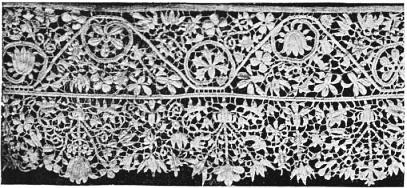
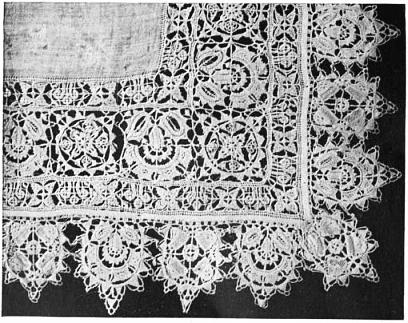


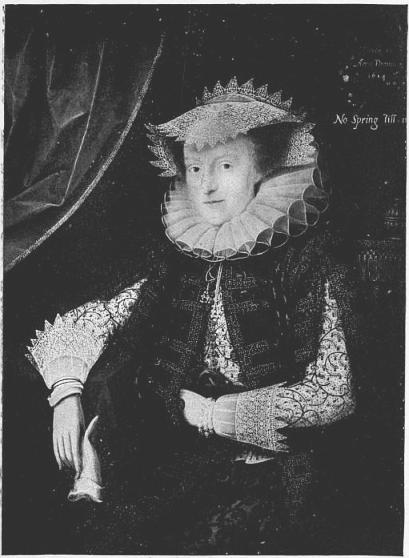


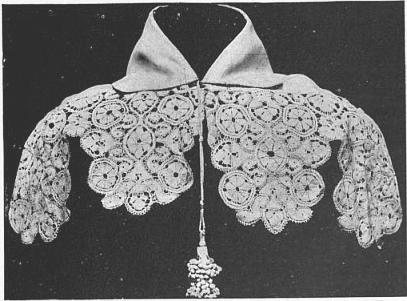










 KSF
KSF